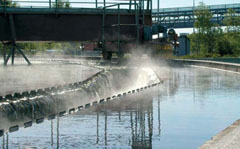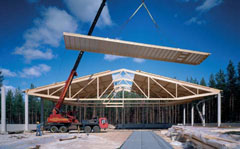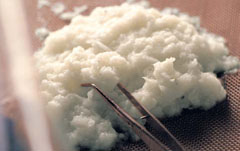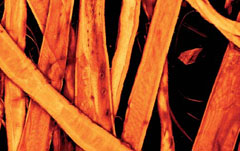| Defibration of wood
Papermaking fibres are currently produced by chemical, chemimechanical, thermomechanical and mechanical pulping processes. Generally the mechanical pulping processes are energy consuming and they degrade the wood cells while the chemical pulping processes produce energy and a pulp composed of intact cells. Intact wood fibres could also be obtained if the mechanical pulping were carried out above the glass transition temperature of the middle lamella lignin (170-180 o C). In such a case the energy consumption of the mechanical pulping would be low while the fibres would be hydrophobic due to their high surface lignin content.
The objective of this part of the research is to get understanding on the mechanisms of the different defibration alternatives and to evaluate their potential taking in to account the energy and material balances as well as the possibility of producing liquid fuels and chemicals (including the wood polymers) as a part of a biorefinery. Pretreatment subprocesses will be considered if they will increase the “sustainability” of the overall process. The emphasis will be in understanding the defibration phenomena on molecular subcellular levels. Several rather exceptional experiments have already been done in this area which could make the current kraft cooking technology questionable. New chemical pulping processes that are noticeably faster and better for fibre quality than the present ones seem possible.
The current chemical pulping processes and their fibreline operations damage the cell wall structure of the fibres decreasing their strength by 30-40%. Gentler processes can be developed only if the phenomena leading to the damages are completely understood.
In the future the pressure of using annual plants/vegetation for fibre and energy production will increase. Therefore one part of the research will chart the Finnish and European annual plant/vegetation raw material sources and summarize the proposed and existing paper and energy industry processes that use annual grasses and vegetation as raw materials. The mechanisms of the associated pulping methods will be explained on molecular level and the characteristics and treatment alternatives of the process derived waste waters will be studied. Finally, the eco-efficiency of the most potential methods will be comprehensively investigated.
Cellulose (micro)fibrils
Nanotechnology is currently one of the most promising areas of scientific and technological development. Recent developments in measurement techniques (for instance atomic force microscopy) have made it possible to understand, control and manipulate materials and structures at the nanoscale. This allows new possibilities to introduce functionality into materials and products, such as high mechanical performance, control of hydrophobicity, unique optical, magnetic and electric properties etc.
The stiffness of the wood cell wall is brought by nanoscaled cellulose microfibrils. Due to its small dimensions, high stiffness and strength, nanofibrillar cellulose offers unique possibilities for making of paper and/or composites. Fibrillar cellulose can also be used as a substrate for growing optically efficient fillers for producing of paper. Through surface modification the possible uses of the fibrillar cellulose could be broadened to cover retention aiding, internal sizing, wet strengthening, dry strengthening and surface sizing.
The goal of this part is to develop cost-efficient methods for producing and engineering nanoscaled cellulose fibrils and fibril/filler-based raw material with appropriate properties for forming the paper web. The alternative methods of producing the fibril and fibril/filler materials will be studied in laboratory and pilot scales. The alternatives will be compared with each other in relation to the targeted characteristics of the materials and their production costs including the consumption of energy and fibre raw material.
In order to produce cellulosic fibres and nanostructures with unique surface properties, it is necessary to modify these building elements by suitable means. An inherent problem is that in most instances the modification of cellulosics requires suitable organic solvents, which in most cases result in eco-inefficient processing methods, which are not suitable for large-scale industrial applications. Secondly, chemical modification methods often have inferior topochemical selectivity. More recent, the use of surface charging technology and self-assembly have been developed for the modification of cellulose for more traditional applications in paper manufacturing and these methods are equally suitable for the modification of cellulosic nanoelements.
After charging the surfaces of cellulose fibrils, they can be used as a retention aid, which also gives a significant support on paper strength properties. When surfaces of microfibrils are made hydrophobic, they can be used as internal sizing agents or as surface sizing chemicals that control both the energy and smoothness of paper surface (printing applications). | 





